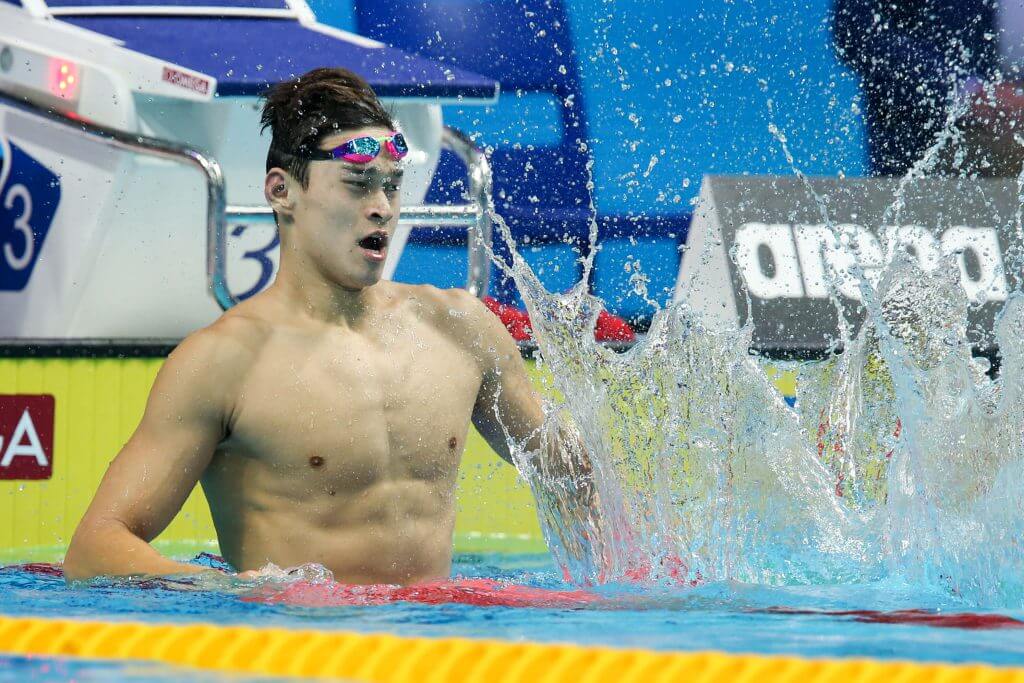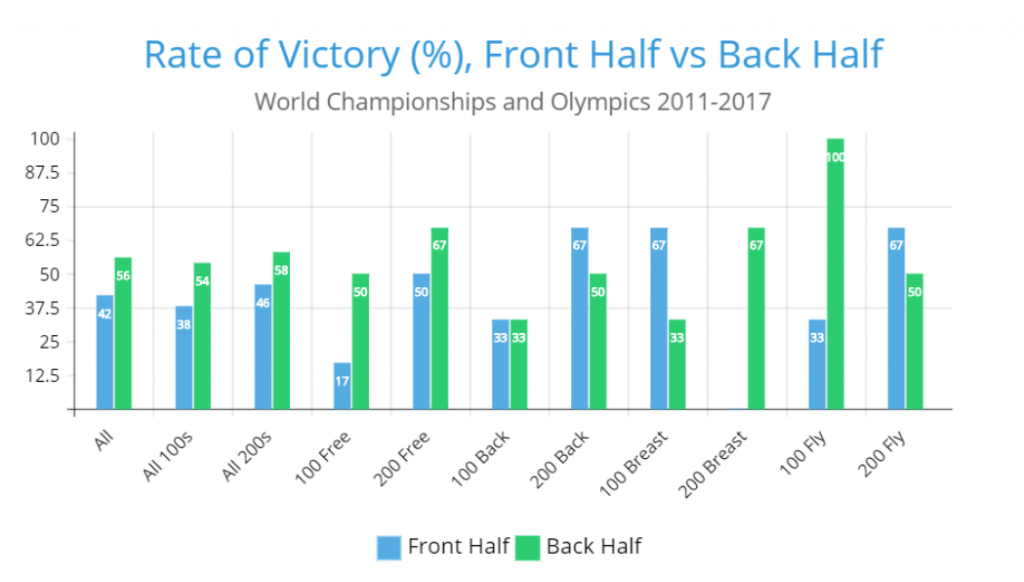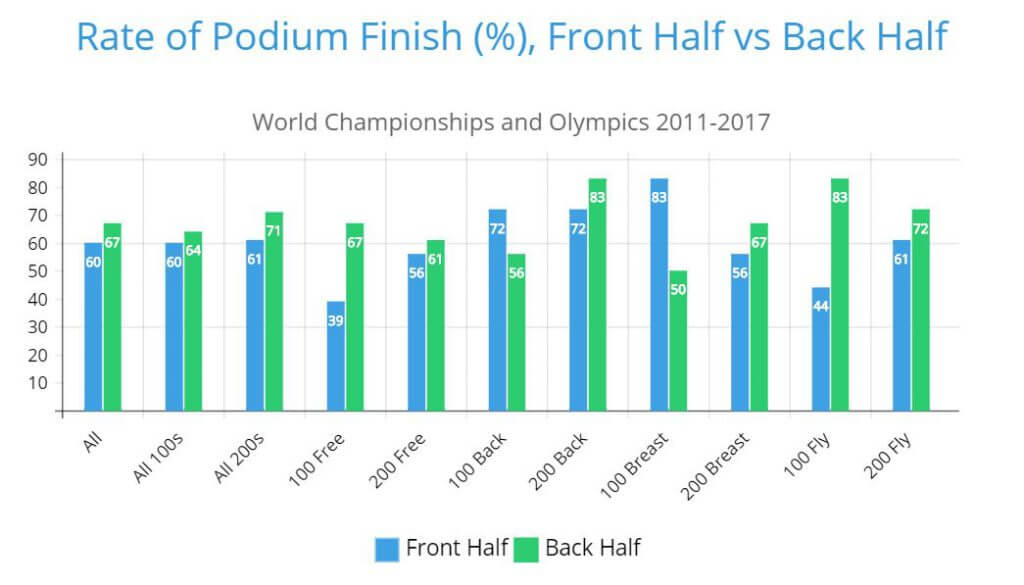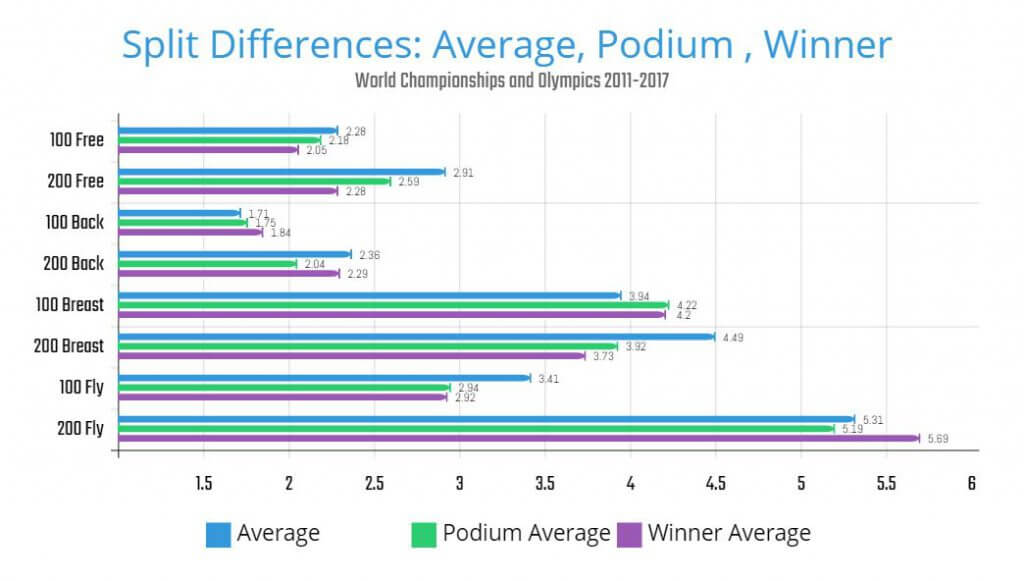The Best Race Strategy for a Top Finish

By Brian Palaschuk, Swimming World College Intern
Swimming fans who watched the Rio Olympics will likely recall Chad le Clos flying to a massive lead in the first 100 of the 200 freestyle, only to be run down by Sun Yang over the final 50 meters to claim silver. You probably also recall Kyle Chalmers blowing past the field to win gold in the 100 freestyle.
In contrast, Ryan Murphy took out the 200 back hard and led wire to wire; Michael Phelps faded at the end but still got his hand on the wall for the 200 fly gold; and Dmitriy Balandin steadily paced himself to victory in the 200 breaststroke.
Who had the right strategy?
Is Yang’s back-half strategy or le Clos’ gutsy front-half swimming the better way to win the race? In hindsight, Yang had the superior strategy by pacing himself to have energy to close in the final length. However, different swimmers use a variety of race strategies that work best for them. Watching the closing 50 meters of the 200 freestyle at the Rio Olympics elicits the following question: What is the best strategy to win a race?
Methodology
To answer the question, we can analyze how swimmers rank at the front half, the back half and the end of their races. The tech-suit era threw a bit of a wrench into data analysis, so its best to analyze data from 2011 and onward. For this reason, we will examine results from men’s 100s and 200s of each stroke at the World Championships and the Olympics from 2011 to 2017.
Take it Out Like a Canon, or Race For the Finish?
Statistically speaking, it is better to come back fast. The swimmer winning at the first half of the race went on to win 41.67 percent of the time. In comparison, the swimmer with the fastest second half won 56.25 percent of the time.
However, not all strokes are equal. It is much more likely to cost a swimmer going out too fast in breaststroke than it is in freestyle. The graph below shows the average percentage of victory for the swimmer with the fastest front half versus back half in each stroke and distance (for men).

Photo Courtesy: Brian Palaschuk
In the 200 back, 100 breast and 200 fly, going out fast was the better strategy. In all other events, back-half speed had a higher success rate. An astounding finding regarding the 100 fly is that the swimmer who came back the fastest won the race 100 percent of the time. Conversely, the swimmer winning at the 100 mark in the 200 breaststroke won zero percent of the time.
Knowing the statistical advantages to a winning race strategy is good; however, most swimmers care about more than just who wins and who loses.
What About for Winning a Medal?
The back half reigns supreme once again. Swimmers who were top three at the front half of their race went on to win medals only 60.42 percent of the time, while 67.36 percent of swimmers with the top three fastest second half splits went on to win a medal.

Photo Courtesy: Brian Palaschuk
With regards to winning the race, it is usually better to come back fast; however, in a few races, the ideal strategies change.
In the 100 fly and free, the back half is key to getting on the podium. We have seen Phelps run down the field time and time again to win the 100 fly, and this strategy works for getting on the podium as well. Top three back-half swimmers win medals 83 percent of the time, compared to the front-end speedsters at 44 percent.
In the 100 breaststroke, it is even more imperative to go out fast to earn a medal than it is to win. The rate of earning a podium finish after starting in the top three is 83 percent as opposed to a measly 50 percent for the fastest back-half swimmers.
The 100 back follows suit, with 72 percent of top three swimmers at the 50m wall going home with a medal. Here, the fastest finishers grabbed a medal only 56 percent of the time.
Results change a lot with the 200s, as the increased distance provides more room to make moves.
In both back and fly, a fast back half becomes the better bet when it comes to getting on the podium. The odds of earning podium honors for swimmers in the top three fastest back half splits are 83 percent and 72 percent respectively. This is illustrated in both the London and Rio Olympic finals, where it wasn’t necessarily important to be out with the top three; however, bringing it home strong usually got a medal.
In the 200 breast and free, your odds of finishing in the top three are pretty similar no matter the strategy. Whether you go out fast or bring it back fast, you have about the same chance of standing on the podium. We have seen this time and time again, particularly with the opposing strategies of le Clos and Yang.
How Slow is Too Slow?
We’ve observed that it is usually better to come back fast than to go out fast. But how do you go about judging how much to save in the first half for a speedy second half? For this distinction, we can analyze split differences: the time between the first half and second half of the race.
For this graph, a larger number indicates a large positive split. That means that the swimmer came back a lot slower than they went out. A number closer to zero indicates an even split. The swimmer came back close to as fast as they went out. Usually, a more even split is better. However, in swimming there are advantages to leading the race. A leading swimmer experiences no turbulence from the kick and splashes of surrounding swimmers. For this reason, a more positive split can sometimes be better.

Photo Courtesy: Brian Palaschuk
This graph compares the average split difference to the winning split difference, to the average podium split difference. Here we notice that much of what we have previously observed is still true.
In the 100 breast and 100 back, winning is all about the front-end speed. It is best to split more positively than the average swimmer in the heat, which means that even though a swimmer may be coming back slower than the average, being ahead early will help them to win.
If you want to win the 200 fly, it is in your best interest to split more positively than the rest of the field; however, it is best to split more evenly to get on the podium. This mirrors our analysis of the rankings. Going out with fast will help a swimmer to win a 200 fly, but saving some energy for the last 100 will help them land on the podium.
In all other events, splitting more evenly than the average will generally be to your benefit. This makes sense, because a more even split generally means you will be catching up to the field, giving you a better chance to win.
Swim Nerd Tidbits
- In the 48 races analyzed, only one negative split appeared: Radosław Kawecki’s silver medal performance in the 200 back at 2013 World Championships.
- The swimmer who led at the front half of 200 breast never won the race.
- The most positive split difference was László Cseh’s 200 fly in Rio; his 8.68-second margin is over a second larger than any breaststroke swimmer.
- Chad le Clos’ 4.48 positive split in the 200 freestyle Rio was huge, but Cameron McEvoy holds the honors with a larger split in both 200 free finals he contested.
- In Rio, Xu Jiayu had the most even split in 200 back, and Evgeny Rylov had the most even split in the 100. In Budapest, Jiayu won the 100 back with the most positive split of the field, while Rylov won the 200 back with the most positive split.
- Only two swimmers broke 1:05 on the back half of a 200 breast: Dániel Gyurta in 2013 and Anton Chupkov in 2017.
- Only two swimmers broke 59 in the back half of a 200 fly: le Clos in 2012 and Switowski in 2015.
- When it looks like a blowout, it probably is. Adam Peaty, Phelps, Yannick Agnel, Murphy, Ryan Lochte, Joseph Schooling, and Caeleb Dressel have all had both the fastest front and back halves in races. However, from 2011 to 2017, only Peaty and Agnel did it twice.
Commentary: All commentaries are the opinion of the author and do not necessarily reflect the views of Swimming World Magazine nor its staff.



